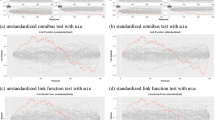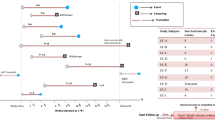Abstract
The proportional hazards mixed-effects model (PHMM) was proposed to handle dependent survival data. Motivated by its application in genetic epidemiology, we study the interpretation of its parameter estimates under violations of the proportional hazards assumption. The estimated fixed effect turns out to be an averaged regression effect over time, while the estimated variance component could be unaffected, inflated or attenuated depending on whether the random effect is on the baseline hazard, and whether the non-proportional regression effect decreases or increases over time. Using the conditional distribution of the covariates we define the standardized covariate residuals, which can be used to check the proportional hazards assumption. The model checking technique is illustrated on a multi-center lung cancer trial.
Similar content being viewed by others
References
Chang IS and Hsiung CA (1996). An efficient estimator for proportional hazards models with frailties. Scand J Stat 23: 13–26
Chang IS, Hsiung CA, Wang MC and Wen CC (2005). An asymptotic theory for the nonparametric maximum likelihood estimator in the Cox gene model. Bernoulli 11: 863–892
Cox DR (1972). Regression models and life tables (with discussion). J R Stat Soc, Ser B 34: 187–220
Cox DR (1975). Partial likelihood. Biometrika 62: 269–276
Economou P and Caroni C (2005). Graphical tests for the assumption of gamma and inverse Gaussian frailty distribution. Lifetime Data Anal 11: 565–582
Gail MH, Wieand S and Piantadosi S (1984). Biased estimates of treatment effect in randomized experiments with nonlinear regressions and omitted covariates. Biometrika 71: 431–444
Glidden DV (1999). Checking the adequacy of the gamma frailty model for multivariate failure time. Biometrika 86: 381–393
Glidden DV and Vittinghoff E (2004). Modelling clustered survival data from multicenter clinical trials. Stat Med 23: 369–388
Gray R (1995). Test for variation over groups in survival data. J Am Stat Assoc 90: 198–203
Heagerty PJ and Zheng Y (2005). Survival model predictive accuracy and ROC curves. Biometrics 61: 92–105
Hougaard P (2000) Analysis of multivariate survival Data. Springer-Verlag
Jiang J (1998). Asymptotic properties of the empirical BLUP and BLUE in mixed linear models. Stat Sin 8: 861–886
Kosorok MR, Lee BL, Fine JP (2001) Semiparametric inference for proportional hazards frailty regression models. Technical report, Department of Biostatistics, University of Wisconsin.
Kosorok MR, Lee BL and Fine JP (2004). Robust inference for proportional hazards univariate frailty regression models. Ann Statist 32: 1448–1491
Lagakos SW and Schoenfeld DA (1984). Properties of proportional-hazards score tests under misspecified regression models. Biometrics 40: 1037–1048
Lancaster T and Nickell S (1980). The analysis of re-employment probabilities for the unemployed. J R Stat Soc, Ser A 143(2): 141–165
Li H, Thompson EA and Wijsman EM (1998). Semiparametric estimation of major gene effects for age of onset. Gen Epidemiol 15: 279–298
Liu I, Blacker DL, Xu R, Fitzmaurice G, Lyons MJ and Tsuang MT (2004). Genetic and environmental contributions to the development of alcohol dependence in male twins. Archives of General Psychiatry 61: 897–903
Liu I, Blacker DL, Xu R, Fitzmaurice G, Tsuang MT and Lyons MJ (2004). Genetic and environmental contributions to age of onset of alcohol dependence symptoms in male twins. Addiction 99(11): 1403–1409
Liu I, Xu R, Blacker DL, Fitzmaurice G, Lyons MJ and Tsuang MT (2005). The application of a proportional hazards model with random effects to twin data. Beha Gen 190(2): 781–789
Ma R, Krewski D and Burnett RT (2003). Random effects Cox model: a Poisson modelling approach. Biometrika 90: 157–169
Murphy S (1994). Consistency in a proportional hazards model incorporating a random effect. Ann Stat 22: 712–731
Murphy S (1995). Asymptotic theory for the frailty model. Ann of Stat 23: 182–198
Murphy S and Vaart A (2000). On profile likelihood. J Am Stat Asso 95: 449–485
Murray DM, Varnell SP and Blitstein JL (2004). Design and analysis of group-randomized trials: a review of recent methodological developments. A J Public Health 94: 423–432
O’Quigley J (2003). Khmaladze-type graphical evaluation of the proportional hazards assumption. Biometrika 90: 577–584
O’Quigley J and Stare J (2002). Proportional hazards models with frailties and random effects. Stat Med 21: 3219–3233
O’Quigley J, Xu R (1998) Goodness-of-fit in survival analysis. In: Armitage P, Colton T (eds) Encyclopedia of Biostatistics, vol 2. Wiley, pp 1731–1745
O’Quigley J and Xu R (2001). Explained variation in proportional hazards regression. In: Crowley, J (eds) Handbook of Statistics in Clinical Oncology, pp 397–410. Marcel Dekker, Inc., New York
Parner E (1998). Asymptotic theory for the correlated gamma-frailty model. The Annals of Statistics 26: 183–214
Paik MC, Tsai WY and Ottman R (1994). Multivariate survival analysis using piecewise gamma frailty. Biometrics 50: 975–988
Ripatti S, Gatz M, Pedersen NL and Palmgren J (2003). Three-state frailty model for age at onset of dementia and death in Swedish twins. Gen Epidemiol 24: 139–149
Ripatti S, Larsen K and Palmgren J (2002). Maximum likelihood inference for multivariate frailty models using an automated Monte Carlo EM algorithm. Lifetime Data Anal 8: 349–360
Ripatti S and Palmgren J (2000). Estimation of multivariate frailty models using penalized partial likelihood. Biometrics 56: 1016–1022
Shorack GR and Wellner JA (1986). Empirical Processes with Applications to Statistics. Wiley, New York
Solomon PJ (1984). Effect of misspecification of regression models in the analysis of survival data. Biometrika 71: 291–298
Spiekerman CF and Lin DY (1996). Checking the marginal Cox model for correlated failure time data. Biometrika 83: 143–156
Struthers CA and Kalbfleisch JD (1986). Misspecified proportional hazard models. Biometrika 73: 363–369
Sylvester R, Collette L, Suciu S, Baron B, Legrand C, Gorlia T, Collins G, Coens C, Declerck L, Therasse P and Glabbeke M (2002). Statistical methodology of phase III cancer clinical trials: advances and future perspectives. Eur J Cancer 38: S162–S168
Vaida F and Xu R (2000). Proportional hazards model with random effects. Stat Med 19: 3309–3324
Viswanathan B and Manatunga AK (2001). Diagnostic plots for assessing the frailty distribution in multivariate survival data. Lifetime Data Anal 7: 143–155
Xu R (2004). Proportional hazards model with mixed effects: a review with applications to twin data. Metodoloski Zvezki: J Stat Soc Slovenia 1(1): 205–212
Xu R, Gamst A, Donohue M, Vaida F, Harrington DP (2006) Using profile likelihood for semiparametric model selection with application to proportional hazards mixed models. Harvard University Biostatistics Working Paper Series. http://www.bepress.com/harvardbiostat/paper43.
Xu R and Harrington DP (2001). A semiparametric estimate of treatment effects with censored data.. Biometrics 57: 875–885
Xu R and O’Quigley J (2000). Estimating average regression effect under non-proportional hazards. Biostatistics 1: 423–439
Xu R and O’Quigley J (2000). Proportional hazards estimate of the conditional survival function. J R Stat Soc Ser B 62: 667–680
Yau KKW (2001). Multilevel models for survival analysis with random effects. Biometrics 57: 96–102
Yau KKW and McGilchrist CA (1998). ML and REML estimation in survival analysis with time dependent correlated frailty. Stat in Med 17: 1201–1214
Author information
Authors and Affiliations
Corresponding author
Rights and permissions
About this article
Cite this article
Xu, R., Gamst, A. On proportional hazards assumption under the random effects models. Lifetime Data Anal 13, 317–332 (2007). https://doi.org/10.1007/s10985-007-9041-5
Received:
Accepted:
Published:
Issue Date:
DOI: https://doi.org/10.1007/s10985-007-9041-5




